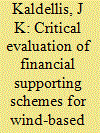|
|
|
Sort Order |
|
|
|
Items / Page
|
|
|
|
|
|
|
| Srl | Item |
| 1 |
ID:
097434


|
|
|
|
|
| Publication |
2010.
|
| Summary/Abstract |
The potential for climate catastrophes, represented by 'fat-tailed' distributions on consequences, has attracted much attention recently. To date, however, most integrated assessment models have either been largely deterministic or deterministic with ex-post sensitivity analysis. The conclusions of such analyses are likely to differ from those employing models that accurately characterize society's joint preferences concerning time and risk, especially when distributions are fat-tailed. Using a dynamic stochastic general equilibrium model adapted from Nordhaus's DICE model, we show that failing to accurately account for risk can lead to substantial underestimation of the net benefits of greenhouse gas abatement. A robust finding of our analysis is that a lenient 'policy ramp' emissions reduction strategy is preferable over a more aggressive strategy-such as that advocated by the Stern Review-only if the model does not account for uncertainty about the climate system, the carbon cycle and economic damages, and specifies a consumption discount rate that is counterfactually higher than the historical global weighted average cost of capital of 4.0%. In the debate over uncertainty and time discounting, our results imply that what matters most in climate change assessment is the inclusion and particular specification of uncertainty rather than the precise choice of discount rate.
|
|
|
|
|
|
|
|
|
|
|
|
|
|
|
|
| 2 |
ID:
171442


|
|
|
|
|
| Summary/Abstract |
Solar photovoltaic (PV) diesel hybrid systems are effective solutions for sustainable energy transition in countries where utility grids are intermittent. An ‘integrated appraisal’ of 'hybrid solar (PV) - diesel' systems are carried out to assess their overall energetic, environmental, financial and economic performances. The study carries out the analysis of hybridized solar photovoltaic energy using first-hand data and information collected from the Palestinian, Lebanese and Iraqi commercial and/or industrial sectors, adopting several scenarios of tariff and diesel fuel prices, capital costs assumptions, solar PV curtailment, and values for environmental damage adopted from life-cycle impact assessment methods that allow for monetization and are globally valid. Results show that hybrid PV-diesel systems have largely beneficial energy, environmental and economic performances in all three countries, whereas their financial performance are also positive for Palestine and Lebanon, however less promising in Iraq, mainly due Iraq's heavily subsidized electricity tariff. The study concludes with policy recommendations focused on promoting solar PV in the commercial and/or industrial sectors, namely: the gradual phasing-out of fossil fuel subsidies, the effective execution of net-metering, the provision of subsidized sustainable energy loans, and carefully designed energy management systems.
|
|
|
|
|
|
|
|
|
|
|
|
|
|
|
|
| 3 |
ID:
115655


|
|
|
|
|
| Publication |
2012.
|
| Summary/Abstract |
The European Commission did not publish a cost-benefit analysis for its 2020 climate package. This paper fills that gap, comparing the marginal costs and benefits of greenhouse gas emission reduction. The uncertainty about the marginal costs of climate change is large and skewed, and estimates partly reflect ethical choices (e.g., the discount rate). The 2010 carbon price in the EU Emissions Trading System can readily be justified by a cost-benefit analysis. Emission reduction is not expensive provided that policy is well-designed, a condition not met by planned EU policy. It is probably twice as expensive as needed, costing one in ten years of economic growth. The EU targets for 2020 are unlikely to meet the benefit-cost test. For a standard discount rate (3% pure rate of time preference), the benefit-cost ratio is rather poor (1/30)-so that benefits need to be very much higher, or costs very much lower than typically assumed to justify the 2020 targets. Only a very low discount rate (0% PRTP) would justify the 20% emission reduction target for 2020.
|
|
|
|
|
|
|
|
|
|
|
|
|
|
|
|
| 4 |
ID:
171427


|
|
|
|
|
| Summary/Abstract |
Mitigation strategies towards progressive decarbonization of the energy system are a valid approach to slow environmental pollution yielding social benefits, as established from National Energy and Climate Plan (NECP). The first objective is the increase of energy efficiency within 2030 by promoting the use of renewable energy and the electrification of consumption in other sectors (household and transport). Cost-benefit analysis (CBA) is an analytical tool to evaluate investments and support policy decisions for society's welfare. The paper aims to assess how CBA can be used to quantify the costs and related social benefits in different sectors (energy, transport and household) if the decarbonization scenario is applied in Italy in 2030. Overall, our findings show positive benefits obtained with the adoption of different mitigation strategies for all sectors. These results can provide significant support to decision-makers in the implementation of decarbonization scenario in Italy scheduled for 2030.
|
|
|
|
|
|
|
|
|
|
|
|
|
|
|
|
| 5 |
ID:
099867


|
|
|
|
|
| Publication |
2010.
|
| Summary/Abstract |
We gauge the cost of crime in Italy by concentrating on a subset of offences covering about 64% of total recorded crimes in the year 2006. Following the breakdown of costs put forward by Brand and Price, we focus on the costs in anticipation, as a consequence, and in response to a specific offence. The estimated total social cost is more than €38 billion, which amounts to about 2.6% of Italy's GDP. To show the usefulness of these measures, we borrow the elasticity estimates from recent studies concerning the determinants of crime in Italy and calculate the cost associated with the surge in crime fuelled by unemployment and pardons. Indeed, in both cases such costs are substantial, implying that they should no longer be skipped when assessing the relative desirability of public policies towards crime.
|
|
|
|
|
|
|
|
|
|
|
|
|
|
|
|
| 6 |
ID:
104912


|
|
|
|
|
| Publication |
2011.
|
| Summary/Abstract |
After a long stagnating period during the second half of the 1990s, the market of wind energy in Greece was described by remarkable but unstable growth rates that resulted in the operation of 1 GW of wind power by the end of 2009. Still though, penetration of wind energy is not the one anticipated. On the other hand, national targets regarding the Renewable Energy Sources' (RES) contribution and existence of excellent wind potential areas across Greece challenge new wind energy investments. Acknowledging the unsteady development rates of wind power in Greece, efficiency of the State support mechanisms is currently investigated. Based on an analytical evaluation model, the investigation undertaken is extended to provide a detailed cost-benefit analysis of several wind energy case studies, including mainland and island applications as well as comparison with both conventional power stations and photovoltaic plants. For this purpose, the financial support provided by the State is directly compared with benefits accruing from the operation of wind parks, considering also the avoidance of social costs deriving from thermal power stations. Based on the results obtained, the beneficial characteristics of wind energy applications for the Greek society are clearly demonstrated, especially in the case of non-interconnected island grids.
|
|
|
|
|
|
|
|
|
|
|
|
|
|
|
|
| 7 |
ID:
125610


|
|
|
|
|
| Publication |
2013.
|
| Summary/Abstract |
This paper analyzes the effects of the green transformation on the German electricity sector with respect to the energy-political triangle. It focuses on how the development of renewable energies will affect security of electricity supply. In a cost-benefit analysis, the value of supply security is compared with its costs of provision. More specifically, the benefits of maintaining the present quality of electricity supply are the avoided social damages from electricity outages and are compared with the respective investment costs in the low- and medium-voltage distribution grid. It is shown that the transformation process towards a green and decentralized production structure will be costly for society, even though the costs can be reduced by different measures.
|
|
|
|
|
|
|
|
|
|
|
|
|
|
|
|
| 8 |
ID:
092810


|
|
|
|
|
| Publication |
2009.
|
| Summary/Abstract |
Vertical unbundling in the electricity sector is a hot political topic in the European Union. The European Commission has decided that the ownership unbundling of transmission networks from other stages in the value chain is the most effective way to ensure fair network access and infrastructure investment. While this European unbundling debate has not ended yet and most countries still do not have an independent transmission system operator (TSO), the Dutch government has already taken one step further. In 2008, it decided that distribution companies should be completely separated from commercial activities that are part of the same holding (generation, trade and supply). This governmental decision has been fiercely debated. Although the goal is to improve competition as well as security of supply, these benefits are uncertain. Nevertheless, it is certain that ownership unbundling comes at a cost. In this paper we present an ex ante cost-benefit analysis of the Dutch unbundling act. We conclude that it is unlikely that this act is welfare enhancing: divorce comes at a price.
|
|
|
|
|
|
|
|
|
|
|
|
|
|
|
|
| 9 |
ID:
111098


|
|
|
|
|
| Publication |
2012.
|
| Summary/Abstract |
In order to reduce the energy consumption of the building stock, a major trend is to drastically reduce the space-heating (SH) needs by improving the thermal performance of the envelope. In general, this measure is combined with efficient heating systems to minimize the delivered energy and greenhouse gas emissions. Nevertheless, these better systems are often more expensive so that the extra-investment could be hardly recovered for small-scale energy consumption. The main objective of the article is to show how equilibria between cost-effectiveness and environmental performance of heating systems are changed when small SH needs are considered (i.e. for passive and low-energy houses). The scope is limited to new single-family dwellings. Furthermore, the passive house standard provides means of simplifying the SH by using the ventilation air: the idea is that savings should counterbalance the extra-investment in super-insulation. In theory, a new global economic optimum is generated at the passive house level. The second objective of the work is to study which conditions could lead to this new optimum. Only a detached-house typology is investigated to address this last issue. Regarding methodology, all the investigations are done considering the Belgian context. Energy and environmental performance is evaluated using a method that complies with the EN-15603 and EN-15316 standards.
|
|
|
|
|
|
|
|
|
|
|
|
|
|
|
|
| 10 |
ID:
126495


|
|
|
|
|
| Publication |
2013.
|
| Summary/Abstract |
This paper addresses the problem of transmission planning in interconnected power systems under the uncertainty of future generation parks and fast varying marginal production costs. The decision maker has to consider many different aspects during the definition of different transmission planning strategies that sometimes might even be contradicting. Major contributions are the incorporation of energy policy measurements in the evaluation process of candidate transmission plans and the inclusion of short- and long-term uncertainties. The proposed methodology, so-called C-TRAP, is based on a semi-dynamic heuristic approach that solves the social welfare maximization problem for several discrete steps considering different preferences for energy policy and transmission network reinforcements. The flexibility provided through the heuristic analysis is very important for decision makers in the new uncertain environment in power systems.
|
|
|
|
|
|
|
|
|
|
|
|
|
|
|
|
| 11 |
ID:
093530


|
|
|
|
|
| Publication |
2010.
|
| Summary/Abstract |
This paper contains a tentative suggestion of how to take into account the value of changes in price volatility in real world cost-benefit analyses. Price volatility is an important aspect of security of supply which first of all concerns physical availability, but assuming that consumers are risk averse, security of supply can also be viewed as a matter of avoiding oscillations in consumption originating from volatile prices of for instance oil. When the government makes transport-related choices on behalf of the consumers, the effect on oscillations in general consumption should be included in the policy assessment taking into account the most significant correlations between prices of alternative fuels and between fuel prices and consumption in general. In the present paper, a method of valuing changes in price volatility based on portfolio theory is applied to some very simple transport-related examples. They indicate that including the value of changes in price volatility often makes very little difference to the results of cost-benefit analyses, but more work has to be done on quantifying, among other things, consumers' risk aversion and the background standard deviation in total consumption before firm conclusions can be drawn.
|
|
|
|
|
|
|
|
|
|
|
|
|
|
|
|
| 12 |
ID:
104915


|
|
|
|
|
| Publication |
2011.
|
| Summary/Abstract |
In the case of the telecommunication (T/C) services' expansion to rural and remote areas, the market generally responds with the minimum investments required. Considering the existing situation, cost-effective operation of the T/C infrastructure installed in these regions (i.e. remote T/C stations) becomes critical. However, since in most cases grid-connection is not feasible, the up-to-now electrification solution for remote T/C stations is based on the operation of costly, oil consuming and heavy polluting diesel engines. Instead, the use of photovoltaic (PV)-based hybrid power stations is currently examined, using as a case study a representative remote T/C station of the Greek territory. In this context, the present study is concentrated on the detailed cost-benefit analysis of the proposed solution. More precisely, the main part of the analysis is devoted to develop a complete electricity production cost model, accordingly applied for numerous oil consumption and service period scenarios. Note that in all cases examined, zero load rejections is a prerequisite while minimum long-term cost solutions designated are favorably compared with the diesel-only solution. Finally, a sensitivity analysis, demonstrating the impact of the main economic parameters on the energy production cost of optimum sized PV-diesel hybrid power stations, is also provided.
|
|
|
|
|
|
|
|
|
|
|
|
|
|
|
|
| 13 |
ID:
117242


|
|
|
|
|
| Publication |
2013.
|
| Summary/Abstract |
Improving the energy economics of manufacturing is essential to revitalizing the industrial base of advanced economies. This paper evaluates ex-ante a federal policy option aimed at promoting industrial cogeneration-the production of heat and electricity in a single energy-efficient process. Detailed analysis using the National Energy Modeling System (NEMS) and spreadsheet calculations suggest that industrial cogeneration could meet 18% of U.S. electricity requirements by 2035, compared with its current 8.9% market share. Substituting less efficient utility-scale power plants with cogeneration systems would produce numerous economic and environmental benefits, but would also create an assortment of losers and winners. Multiple perspectives to benefit/cost analysis are therefore valuable. Our results indicate that the federal cogeneration policy would be highly favorable to manufacturers and the public sector, cutting energy bills, generating billions of dollars in electricity sales, making producers more competitive, and reducing pollution. Most traditional utilities, on the other hand, would lose revenues unless their rate recovery procedures are adjusted to prevent the loss of profits due to customer owned generation and the erosion of utility sales. From a public policy perspective, deadweight losses would be introduced by market-distorting federal incentives (ranging annually from $30 to $150 million), but these losses are much smaller than the estimated net social benefits of the federal cogeneration policy.
|
|
|
|
|
|
|
|
|
|
|
|
|
|
|
|
| 14 |
ID:
125492


|
|
|
|
|
| Publication |
2013.
|
| Summary/Abstract |
The inclusion of greenhouse gas (GHG) emissions costs in energy systems investment decision-making requires the development of a framework that accounts for GHG and economic tradeoffs. This paper develops such a framework by integrating partial cost-benefit analysis with life cycle assessment to explore the question of whether bitumen should be upgraded in the Canadian province of Alberta to produce synthetic crude oil (SCO), or blended with light hydrocarbons to produce lower-quality diluted bitumen (dilbit). The net present value (NPV) of these options is calculated from the stakeholder perspectives of the oil sands industry, the Alberta public, and a climate-concerned Alberta resident. This calculation includes monetized GHG emissions costs stemming from a hypothetical economy-wide GHG price, and a sensitivity analysis explores the effects of variations in technical and economic conditions on stakeholders' preferences. We find that under most plausible sets of conditions, industry would prefer the dilution option, while the climate-concerned Alberta resident would prefer the upgrading option. In contrast, the preferences of the general Alberta public depend on the values of key variables (e.g., the SCO-dilbit price differential). Key drivers of differences among stakeholders' preferences include different perceptions of risks and responsibilities for life cycle GHG emissions.
|
|
|
|
|
|
|
|
|
|
|
|
|
|
|
|
| 15 |
ID:
047088


|
|
|
|
|
| Publication |
San Diego, Academic Press, 2001.
|
| Description |
xvii, 500p.
|
| Standard Number |
0122210905
|
|
|
|
|
|
|
|
|
|
|
|
Copies: C:1/I:0,R:0,Q:0
Circulation
| Accession# | Call# | Current Location | Status | Policy | Location |
| 044382 | 333.7/DOR 044382 | Main | On Shelf | General | |
|
|
|
|
| 16 |
ID:
114296


|
|
|
|
|
| Publication |
2012.
|
| Summary/Abstract |
Gaining public acceptance is one of the main issues with large-scale low-carbon projects such as hydropower development. It has been recommended by the World Commission on Dams that to gain public acceptance, public involvement is necessary in the decision-making process (WCD, 2000). As financially-significant actors in the planning and implementation of large-scale hydropower projects in developing country contexts, the paper examines the ways in which public involvement may be influenced by international financial institutions. Using the case study of the Nam Theun 2 Hydropower Project in Laos, the paper analyses how public involvement facilitated by the Asian Development Bank had a bearing on procedural and distributional justice. The paper analyses the extent of public participation and the assessment of full social and environmental costs of the project in the Cost-Benefit Analysis conducted during the project appraisal stage. It is argued that while efforts were made to involve the public, there were several factors that influenced procedural and distributional justice: the late contribution of the Asian Development Bank in the project appraisal stage; and the issue of non-market values and discount rate to calculate the full social and environmental costs.
|
|
|
|
|
|
|
|
|
|
|
|
|
|
|
|
|
|
|
|
|